How many batters have scored their first and second centuries in the same Test?
In memory of Cricinfo pioneer Travis Basevi, who died last week, and made many invaluable contributions to this column

Yasir Hameed is one of two batters to score two hundreds in his first Test • Jewel Samad/AFP/Getty Images
Like everyone else connected with ESPNcricinfo, I was deeply saddened to hear of the death of Travis Basevi last week, at the young age of 47. His lasting memorial will be the superb StatsGuru, but he was also responsible for creating much of the site's database in the first place, and much more besides. He was a great help during my time as Cricinfo's editor, and afterwards, when he continued to help out with arcane queries for this column. When he finally left, I wished him well and said I hoped he hadn't been diverted too much from real work by Ask Steven. "Don't worry," he said. "Your requests were far from irritating, they were the stuff I'd thrive on."
It's obviously difficult to quantify this sort of thing exactly, but I asked ESPNcricinfo's ace number-cruncher Travis Basevi whether he could come up with a formula. He told me that, excluding extras and run-outs, the overall bowling average in all Tests is 31.43. That means that the smallest contribution to New Zealand's fine win at Headingley was by Ross Taylor (68 runs, no wickets), as Kane Williamson's contribution was 100.29 (six runs plus three wickets at 31.43) and Matt Henry's 101.86.
- June 9, 2015

Two men have scored twin centuries in their very first Test: Lawrence Rowe made 214 and 100 not out for West Indies against New Zealand in Kingston in 1971-72, and Yasir Hameed echoed his feat with 170 and 105 for Pakistan vs Bangladesh in Karachi in 2003-04. Seven others before Fulton had followed their maiden Test century with another one in the same match - but where Fulton does lead the way is that it took him till his 13th Test to achieve the feat: another New Zealander, Geoff Howarth, is next with 11 (vs England in Auckland in 1977-78).
- April 9, 2013. "Nice one," said Travis. "Fulton's effort totally escaped me the other week."
It's true that Brendon McCullum's two highest Test scores - 302 against India in Wellington in 2013-14, and 225 against India in Hyderabad in 2010-11 - both came in New Zealand's second innings. His next-highest of 224 - also against India - was in the first innings in Auckland in 2013-14, a week before that triple-century. The batter who enjoyed the second innings the most turns out to be Bangladesh's Al Sahariar, whose seven highest scores - ranging from 71 down to 34 - all came at the second attempt. Six batters - Ali Bacher (South Africa), Hanson Carter (Australia), Harry Cave (New Zealand), Junaid Siddique (Bangladesh), Pommie Mbangwa (Zimbabwe) and Shane Shillingford (West Indies) - all recorded their five highest scores in the second innings. Of that group, Junaid was the only one to make a century (106 against England in Chittagong in 2009-10), while Mbangwa's scores ranged from 8 to 3. His highest first-innings score was 2 not out. In all Mbangwa collected nine ducks (and eight not-outs) in 25 Test innings.
- June 30, 2015. Luckily, Travis was "intrigued by the first part".

There have actually been two higher individual scores than David Warner's 253 in Perth that didn't lead to the player concerned winning the Player-of-the-Match award. Highest of all was Kumar Sangakkara's 287, for Sri Lanka against South Africa in Colombo in 2006, when the award went to Mahela Jayawardene for his 374 (it might have been fairer to make a joint award, which happens sometimes). In Wellington in 1990-91, Aravinda de Silva's 267 for Sri Lanka was trumped by Martin Crowe's 299 for New Zealand. When Sachin Tendulkar made his highest Test score - 248 not out against Bangladesh in Dhaka in 2004-05 - the award went to Irfan Pathan, who took 11 wickets for 96 in the match. I should point out here that such awards only became commonplace in Test matches in the 1980s.
- December 1, 2015. Travis: "It's Sangakkara getting dudded when Jayawardene made 374 - I guess the adjudicator never realised you could give it to both of them."
The England side for the third Test against Pakistan in Sharjah did include four men - James Anderson, Stuart Broad, Ben Stokes and Moeen Ali - who bat left-handed but bowl with their right, plus Samit Patel, a right-hand batter but a slow left-arm bowler. I couldn't think of any bigger numbers - but Travis Basevi, Cricinfo's database ace, unearthed a couple. As England's first Test against India at Trent Bridge in 2014 meandered to a draw, Alastair Cook and Gary Ballance both had a trundle - and they each bowl right-handed but bat left. They joined Moeen, Anderson, Broad and Stokes to make up the half dozen.
- November 10, 2015
Steven Lynch is the editor of the updated edition of Wisden on the Ashes